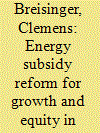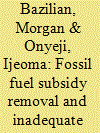|
|
|
Sort Order |
|
|
|
Items / Page
|
|
|
|
|
|
|
| Srl | Item |
| 1 |
ID:
168320


|
|
|
|
|
| Summary/Abstract |
This paper investigates the perspectives of commercial and industrial consumers on electricity pricing reform in Uttar Pradesh, India. In a first study of its kind, we report results from semi-structured, in-depth interviews that were conducted with a variety of firms, based on their electricity price dependence and employment. Results show that senior management officials already strongly oppose cross-subsidy policies in which they pay higher tariffs to reduce prices for households and farmers. Firms also have very few available coping mechanisms to deal with further electricity tariff rises. Senior management officials believe their firms will have to compromise on electricity usage if prices are increased again. Available models suggest that this will likely be a cause for lowering output and overall machine and labor productivity. While firms do expect price rises in the short term, they believe this will impact their productivity and have a low opinion of the state government. This might be aggravated by little knowledge about the price setting mechanism, their means of participation and the level of utility dependence on state subsidies.
|
|
|
|
|
|
|
|
|
|
|
|
|
|
|
|
| 2 |
ID:
126556


|
|
|
|
|
| Publication |
2013.
|
| Summary/Abstract |
This paper provides a financial survey of a small sample of Czech photovoltaic (PV) plants. To evaluate the extent of market losses, we calculate the shadow market price of solar electricity. From the profit and loss accounts of the PV plants and the shadow market price we estimate the total economic loss generated by PV electricity sector in the Czech Republic. The presented microeconomic approach has two main advantages: firstly, we work with real observed data, which offsets the drawback of a limited sample. Secondly, the profit accounting calculation enables sensitivity analysis with respect to key variables of the plants. We show that money invested in PV plants would generate an annual loss of 8%. Given the estimated solar assets of CZK 165.6 billion (EUR 6.6 billion) as of December 2011, this translates in at least CZK 12.6 billion lost in the Czech solar sector in 2012. About 43% of this loss is due to high technology costs and corresponds to pure dead weight loss, while the remaining 57% constitute the redistributive profit component of subsidies. Finally, we calculate that unless electricity prices increase or technology costs decrease approximately sevenfold, PV plants will remain loss making.
|
|
|
|
|
|
|
|
|
|
|
|
|
|
|
|
| 3 |
ID:
125510


|
|
|
|
|
| Publication |
2013.
|
| Summary/Abstract |
In this study a mixed integer linear programming (MILP) model is created for the design (i.e. technology selection, unit sizing, unit location, and distribution network structure) of a distributed energy system that meets the electricity and heating demands of a cluster of commercial and residential buildings while minimising annual investment and operating cost. The model is used to analyse the economic and environmental impacts of distributed energy systems at the neighbourhood scale in comparison to conventional centralised energy generation systems. Additionally, the influence of energy subsidies, such as the UK's Renewable Heat Incentives and Feed in Tariffs, is analysed to determine if they have the desired effect of increasing the economic competitiveness of renewable energy systems.
|
|
|
|
|
|
|
|
|
|
|
|
|
|
|
|
| 4 |
ID:
143437


|
|
|
|
|
| Summary/Abstract |
The distributional impact on households is an important factor for the acceptance of energy subsidy reform. Based on energy consumption features of the Chinese households at different income levels, this paper adopts an input–output price model to analyze possible impacts of removing energy subsidies on income distribution under different scenarios. Results show that: (1) The distributional impacts of removing subsidies vary by fossil fuels. From the perspectives of combined effects, transport fuel subsidy removal and coal subsidy removal have the strongest and the weakest progressive effects respectively, while the removal of electricity subsidies has a regressive effect. Moreover, the removal of petroleum product subsidies has the greatest impact on households, followed by the removal of electricity and coal subsidies, respectively. (2) Indirect impacts of energy subsidy reform are greater than direct impacts on households. (3) Government price controls can reduce the negative impact of energy subsidy reform. Policy implications are thus summarized. Energy subsidy reform can start from the energy that has the strongest progressive effect and the minimum impact on households. The Chinese government can take certain compensatory measures to mitigate the impact of reform on poor households.
|
|
|
|
|
|
|
|
|
|
|
|
|
|
|
|
| 5 |
ID:
118848


|
|
|
|
|
| Publication |
2013.
|
| Summary/Abstract |
Energy consumption and efficiency emerged as the hottest topic in the context of China's sustainable development. Energy subsidies and "rebound effect" were closely related to this topic while few combinative studies on them with a focus on China. This paper employed a co-thinking approach, focusing on how the energy subsidies reform could mitigate the rebound effect in China, and how to achieve an "economic and environmental gains" that reduced pecuniary spending, improved the distorted energy market and reduced energy consumption simultaneously. Firstly, with price-gap approach we calculated the total energy subsidies scale of China in 2007, which amounted to582.0 billion CNY; then we detected and identified rebound effect of China energy consumption with the features. Furthermore, based on China 2007 monetary input-output table and energy flow analysis, we compiled a hybrid physical energy input and monetary output model (EIMO) to simulate the mitigation effect of subsidies reform. Results showed that removing energy subsidies would decrease ultimate demand of different economy sectors and reduce the accumulatively physical consumption of coal, oil, natural gas and electricity by 17.74, 13.47, 3.64 and 15.82 million tce, respectively. Finally we discussed relevant policy issues on China's energy subsidies reform in depth.
|
|
|
|
|
|
|
|
|
|
|
|
|
|
|
|
| 6 |
ID:
115145


|
|
|
|
|
| Publication |
2012.
|
| Summary/Abstract |
This paper presents a critical view of Florida's photovoltaic (PV) subsidy system and proposes an econometric model of PV system installation and generation costs. Using information on currently installed systems, average installation cost relations for residential and commercial systems are estimated and cost-efficient scales of installation panel wattage are identified. Productive efficiency in annual generating capacity is also examined under flexible panel efficiency assumptions. We identify potential gains in efficiency and suggest changes in subsidy system constraints, providing important guidance for the implementation of future incentive programs. Specifically, we find that the subsidy system discouraged residential applicants from installing at the cost-efficient scale but over-incentivized commercial applicants, resulting in inefficiently sized installations.
|
|
|
|
|
|
|
|
|
|
|
|
|
|
|
|
| 7 |
ID:
166727


|
|
|
|
|
| Summary/Abstract |
Increasing block pricing schemes represent difficulties for applied researchers who try to recover demand parameters, in particular, price and income elasticities. The Mexican residential electricity tariff structure is amongst the most intricate around the globe. In this paper, we estimate the residential electricity demand and use the corresponding structural parameter estimates to simulate an energy efficiency improvement scenario, as suggested by the Energy Transition Law of December 2015. The simulated program consists of a massive replacement of electric appliances (air conditioners, fans, refrigerators, washing machines, and lights) for more energy-efficient units. The main empirical findings are the following: in the main counterfactual scenario, the overall residential electricity consumption decreases 9.9% and the associated expenditure falls 11.3%. Additionally, the electricity subsidy decreases 7.5 billion of Mexican Pesos per year (i.e., 403 million of USD at the average exchange rate registered in 2017) and there is an annual cut in CO2 emissions of 3.9 million of tons.
|
|
|
|
|
|
|
|
|
|
|
|
|
|
|
|
| 8 |
ID:
176099


|
|
|
|
|
| Summary/Abstract |
Saudi Arabia has regulated domestic energy prices for decades, setting them below international market levels. Energy subsidies in Saudi Arabia are generally implicit because they lead to foregone revenues for the government. Low energy prices also encourage rapid energy demand growth and wasteful consumption, while limiting incentives to invest in energy efficiency. Saudi Arabia recently started to reform energy prices, leading to large increases in gasoline and residential electricity prices in 2018. To measure the economic and environmental impacts of energy price reform, we econometrically model gasoline and residential electricity demand using Harvey's (1990) Structural Time Series Model. Our estimated equations reveal that gasoline demand and residential electricity demand in Saudi Arabia are strongly price and income inelastic, despite the major reforms that were recently implemented. Our welfare analysis also shows that the energy price reforms in 2018 in gasoline and residential electricity respectively delivered welfare gains of 8.8 and 3.8 billion SAR annually (2.3 and 1.0 billion US$). Additionally, our decomposition analysis reveals that these energy price reforms were the largest contributors to the observed decreases in gasoline and residential electricity consumption in 2018.
|
|
|
|
|
|
|
|
|
|
|
|
|
|
|
|
| 9 |
ID:
166475


|
|
|
|
|
| Summary/Abstract |
Phasing out energy subsidies is high on the agenda of policymakers in several Middle Eastern and North African countries. The impact of such reform can vary widely depending on the country and policy. This paper contributes to the existing literature by examining the phasing out of energy subsidies in Egypt under alternative economic scenarios. In particular, we consider Egypt's short- and long-term economic adjustment under different assumptions on labor market flexibility, spending options of subsidy savings, and alternative social protection measures. Results from economy-wide model simulations suggest that energy subsidy cuts may hamper economic growth in the short term, but depending on the policy measure, will improve growth perspectives and household welfare in the longer term. Yet, findings also point to likely adverse impacts of the reform on household consumption in the short and longer run. To counteract such negative impacts, targeted social protection measures should be continued and scaled up in parallel with the phasing out of energy subsidies.
|
|
|
|
|
|
|
|
|
|
|
|
|
|
|
|
| 10 |
ID:
113410


|
|
|
|
|
| Publication |
2012.
|
| Summary/Abstract |
We briefly consider the impact of fossil fuel subsidy removal policies in the context of inadequate power supply, with a focus on the implications for businesses. In doing so, we utilize the case of the early 2012 fuel subsidy removal in Nigeria. The rationale for such subsidy-removal policies is typically informed by analysis showing that they lead to an economically inefficient allocation of resources and market distortions, while often failing to meet intended objectives. However, often the realities of infrastructural and institutional deficiencies are not appropriately factored into the decision-making process. Businesses in many developing countries, already impaired by the high cost of power supply deficiencies, become even less competitive on an unsubsidized basis. We find that justifications for removal often do not adequately reflect the specific environments of developing country economies, resulting in poor recommendations - or ineffective policy.
|
|
|
|
|
|
|
|
|
|
|
|
|
|
|
|
| 11 |
ID:
126537


|
|
|
|
|
| Publication |
2013.
|
| Summary/Abstract |
In China, most energy prices are controlled by the government and are under-priced, which means energy subsidies existing. Reforming energy subsidies have important implications for sustainable development through their effects on energy price, energy use and CO2 emission. This paper applies a price-gap approach to estimate China's fossil-fuel related subsidies with the consideration of the external cost. Results indicate that the magnitude of subsidies amounted to CNY 1214.24 billion in 2008, equivalent to 4.04% of GDP of that year. Subsidies for oil products are the largest, followed by subsidies for the coal and electricity. Furthermore, an input-output model is used to analyze the impacts of energy subsidies reform on different industries and general price indexes. The findings show that removal of energy subsidies will have significant impact on energy-intensive industry, and consequently push up the general price level, yet with a small variation. Removing oil products subsidies will have the largest impact, followed by electricity, coal and natural gas. However, no matter which energy price increases, PPI is always the most affected, then GDP deflator, with CPI being the least. Corresponding compensation measures should be accordingly designed to offset the negative impact caused by energy subsidies reform.
|
|
|
|
|
|
|
|
|
|
|
|
|
|
|
|
| 12 |
ID:
149909


|
|
|
|
|
| Summary/Abstract |
Facing with the increasing contradiction of economic growth, energy scarcity and environmental deterioration, energy conservation and emissions abatement have been ambitious targets for the Chinese government. Improving energy efficiency through technological advancement is a primary measure to achieve these targets. However, the existence of energy rebound effects may completely or partially offset energy savings associated with technological advancement. This paper adopted a modified input-output model to estimate the economy-wide energy rebound effects across China's economic sectors with the consideration of energy subsidies. The empirical results show that the aggregate rebound effect of China is about 1.9% in 2007–2010, thus technological advancement significantly restrains energy consumption increasing. Removing energy subsidies will cause the aggregate rebound effect declines to 1.53%. Specifically, removing subsidies for coal and nature gas can reduce the rebound effects signifcantly, while removing the subsidies for oil products has a small impact on rebound effect. The existence of rebound effects implies that technological advancement should be cooperated with energy price reform so as to achieve the energy saving target. In addition, the government should consider the diversity of economic sectors and energy types when design the reform schedule.
|
|
|
|
|
|
|
|
|
|
|
|
|
|
|
|
| 13 |
ID:
191336


|
|
|
|
|
| Summary/Abstract |
Energy support schemes can either facilitate or restrict the sustainable development of the energy sector. This article reviews the interface and interaction between two types of energy support schemes – renewable energy support schemes and capacity mechanisms – in the European context. It first explains how state aid in the form of these two energy support schemes is regulated in the European Union and, second, shows how this regulation is reflected in national practices of the Member States by exploring the approaches to renewable energy in various capacity mechanisms. This interdisciplinary analysis of the trade-offs and synergies between renewable energy policies and energy security policies in Europe finds that the European experiences are diverse. The article demonstrates how states often operate a conflicting policy mix where renewable energy support facilitates decarbonization while, in many cases, capacity mechanisms simply back up the intermittency of renewable energy sources with fossil-fuel-based energy solutions that hinder the achievement of the energy transition. Facilitating a shift of focus in capacity mechanisms to low-carbon technologies, demand-response, and storage solutions is the first step in resolving the conflicting policy mix.
|
|
|
|
|
|
|
|
|
|
|
|
|
|
|
|
|
|
|
|
|